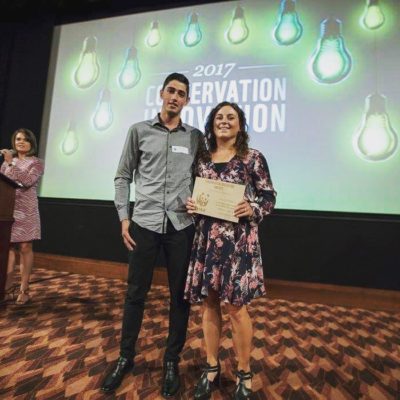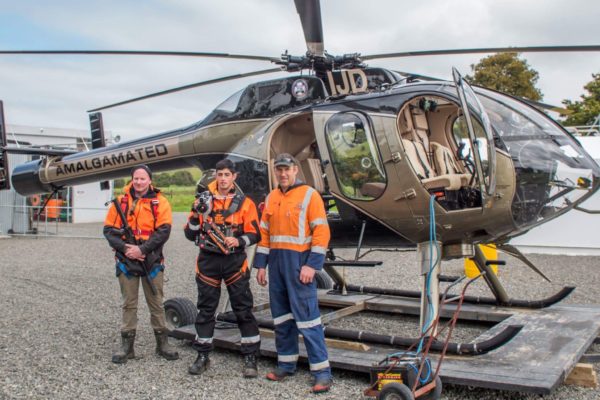Jordan and Mikayla Munn are recent winners of $25,000 in the WWF 2017 Innovation Awards with their venture to use top-of-the-line, military quality, thermal imaging technology to detect and help in the removal of invasive animals.
‘Trap and Trigger Ltd’, the young couple’s conservation and wildlife management company, has already invested hugely in the technology – both in time researching the best equipment to use and in the significant outlay (in the region of $100,000+) needed to buy and adapt the thermal imaging camera gear.

Jordan, a keen hunter, is committed to making a difference when it comes to deer, pigs and goats living in sensitive conservation areas. His expertise is utilised in areas like island sanctuaries and remote locations containing highly endangered species. The operational areas tend to be out of reach for constant recreational hunting pressure and require a systematic approach with reliable techniques to remove the target species to low enough densities to have positive impacts in the ecosystem.
“Ground hunting generally has detection rates of 50% following dispatch rates of 50% leaving an unsuccessful encounter rate of 75%,” Jordan explains. “A daily coverage is also limited to an average of about 170 hectares.”
Compare that to what can be achieved with a Thermal Imaging Detection System (TADS).
“Surveying the same vegetation type, TADS has the ability to detect 90 – 100% of the current population and then remove up to 60% in double canopy forest and 100% in low scrub and alpine tussock. These rates and efficiency can only be increased with more research and better quality equipment.”
So, after researching the possibilities, Jordan invested in the best quality equipment he was able to buy and set about adapting it to New Zealand control and eradication ‘real world’ situations. For example, research models were restricted to the rear seat, creating a break in communications between the pilot, shooter and thermal operator. Trap and Trigger operate their system with the camera operator seated beside the pilot in the front of a helicopter and the shooter positioned directly behind. Both pilot and shooter can see the thermal imagery and work together to line up their target.

“The camera is aligned with a military grade laser pointer to assist the pilot and shooter in the direction of the detected target until it presents itself for identification and dispatch. In the right environment, we can detect ungulates at over a kilometre away,” Jordan adds. “At the moment we are also working on feeding the live footage to a HD headset to fully emerge us in the cameras view therefore giving higher ability of detection.”
Thermal technology has been around for 20 years or so, but it’s the way that Jordan and his team are adapting it to better suit their own conservation operation needs in New Zealand that is new.
“We have studied trials and methods and created an innovative concept based on their limitations such as increasing the field of view or increasing clarity through pixel density and tracking systems through surface temperature readings and increasing mobility with our free floating harness system. We obtained a permit to import an industrial laser to turn our detection device into a tracking and removal system.”
The whole development process has been a new experience for Jordan who started out working as a possum-trapper as a 16-year-old. Now, 9 years later, at 25 years old, he is not just a very experienced contract hunter but has suddenly found himself negotiating laser permits with the Ministry of Health and arranging harness certification.
Jordan’s mobile harness setup has the very practical advantage of not needing to be permanently attached to one particular helicopter. If he gets asked to help with a Search & Rescue callout, for example, he can just grab their thermal imaging gear and mobile harness and hop in any S&R chopper.
Jordan got his ‘commercial hunting break’ as a 17 year-old, just a year after he started possum-trapping for a living.

“I was working for a possum contractor in Southland,” he says. “I was a rural kid and like every outdoors teenager I loved hunting. There was a DOC deer-culling operation and someone got sick midway through an operation, so I was called to step in and join the team – and I cleaned up the older guys. I found out I was a reasonably good hunter,” Jordan explains, “so I trained up my dog as a hunting dog and started getting hired by professional hunters and building up a hunting reputation.”
He was lucky enough to be involved in a few high-profile eradication projects early on in his hunting career, helping to build that all-important professional hunter profile.
“I was involved in the deer eradication on Secretary Island and in a sheep eradication in the Virgin Islands. On Secretary Island there was a massive team – 7 or 8 hunters on a 2 week survey, but because of the vegetation there still wasn’t 100% coverage. Secretary Island is about 8140 hectares,” Jordan says. “Now people are talking about eradicating pigs from the Auckland Islands and that’s about 56,000 hectares. It’s scrubby and almost impenetrable in places and its remote and sub-Antarctic so the weather systems are severe.”
Eradication on a bigger scale isn’t anything like as simple as just upscaling what you did last time.
“You can’t just get 50 hunters instead of 7 or 8 and leave them to it,” says Jordan, “You need better technology as well. Eradication is the pinnacle of a hunting career,” he adds, “because you’re doing something that has a long-lasting effect.”
Jordan credits Te Anau-based DOC senior ranger, sharp-shooter and world-renown eradication expert, Norm Macdonald, for encouraging him to have a progressive attitude to hunting.
“Norm is a huge influence,” says Jordan. “He got me involved in eradication contracts and taught me to look at limitations with a progressive mindset. He’s done eradications all over the world. He’s 62 now and at the moment he’s working on an eradication project in Guam.”
Jordan too has begun to work on international eradication projects and used the profits from a Canadian operation as the deposit for his TADS purchase.
“It was a deer eradication,” Jordan explains. “There was a thermal imager on the project and it wasn’t planned that way, but it became a primary detection tool. We found a lot more deer than expected. So we decided to find the best thermal imager we could and put it to use in our upcoming projects. We went for the highest quality and worked on the limitations. We looked at what had been found in research studies and what worked in the New Zealand situation.”
Jordan had been looking for ways to ‘step up’ the work his company does – part of the philosophy that mentor Norm Macdonald helped instil in him.
“I’d moved from hunting to working on eradications. The aim was then to step up by moving from the ground to the air in a new form,” he says. “People have tried trapping and snare collars and Judas animals, there’s just not many areas left to improve.”
In eradications a single remaining pregnant animal can undo everything.
“So you need many tools,” Jordan says. “You have to use every aspect of detection so that no remaining targets can go undetected.”
Jordan is careful to point out the difference between the eradication work he does and areas used by recreational hunters. One is not a threat to the other, he emphasises. Control on mainland New Zealand isn’t about wiping out all deer and pigs and killing off recreational hunting in the process.
“I’m also a recreational hunter,” he says. “Deer control operations in New Zealand are carried out in specific areas where the aim is to control deer, not remove them. They are controlled because they’re reaching high numbers or to stop them getting somewhere that has high conservation values. There’s always a purpose,” he explains, “Like controlling deer in an area to benefit the kokako. At the moment DOC and HealthPost are looking at removing pigs from Farewell Spit. A lot of different ground-nesting birds breed there and the pigs eat the eggs.”
While deer are introduced mammals, they’re not predators. Pigs, however, are predators and while his TADS equipment is currently being developed for larger introduced mammals, Jordan can see it evolving over time to be used for smaller introduced predators too.
“At the moment the thermal camera can spot possums in the canopy,” he says, “But it’s not worth flying around to get possums. What we have now won’t help with stoats and possums, but it will help with pigs.”
In future, possums and stoats may be in the sights too. The technology could also, potentially, be developed for monitoring native wildlife such as bats or takahe in remote, inaccessible Fiordland Valleys.
“Mikayla and I decided to dedicate our company to wildlife management,” Jordan says. “We want to make a difference – to be at the front, not at the back – moving forward and getting results.”
It’s that progressive, innovative mindset that makes Trap and Trigger Hunting well-deserved winners of a 2017 WWF Innovation Award.

